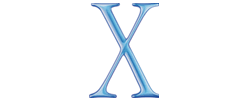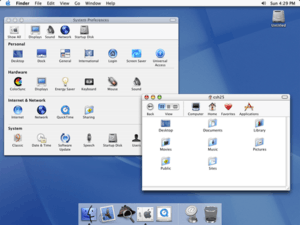Mac OS X 10.1
| A version of the macOS operating system | |
 | |
|
Screenshot of Mac OS X 10.1 Puma Finder and System Preferences | |
| Developer | Apple Computer |
|---|---|
| OS family | |
| Source model | Closed source (with open source components) |
| Released to manufacturing | October 25, 2001 |
| Latest release | 10.1.5 / June 6, 2002[1] |
| Platforms | PowerPC |
| Kernel type | Hybrid (XNU) |
| License | Apple Public Source License (APSL) and Apple end-user license agreement (EULA) |
| Preceded by | Mac OS X 10.0 Cheetah |
| Succeeded by | Mac OS X 10.2 Jaguar |
| Official website | Apple - Mac OS X at the Wayback Machine (archived April 8, 2002) |
| Support status | |
| Unsupported | |
Mac OS X version 10.1, code named Puma, is the second major release of Mac OS X (now named macOS), Apple's desktop and server operating system. It superseded Mac OS X 10.0 and preceded Mac OS X 10.2. Version 10.1 was released on September 25, 2001 as a free update for Mac OS X 10.0 users. The operating system was handed out for no charge by Apple employees after Steve Jobs' keynote speech at the Seybold publishing conference in San Francisco. It was subsequently distributed to Mac users on October 25, 2001 at Apple Stores and other retail stores that carried Apple products. The operating system was better received than Mac OS X 10.0, although critics claimed that the operating system was still lacking some features and was plagued with bugs.
System requirements
Supported computers:
RAM:
Hard Drive Space:
Features
Apple introduced many features that were missing from the previous version, as well as improving overall system performance.
This system release brought some major new features to the Mac OS X platform:
- Performance enhancements — Mac OS X 10.1 introduced large performance increases throughout the system.
- Easier CD and DVD burning — better support in Finder as well as in iTunes
- DVD playback support — DVDs can be played in Apple DVD Player
- More printer support (200 printers supported out of the box) — One of the main complaints of version 10.0 users was the lack of printer drivers, and Apple attempted to remedy the situation by including more drivers, although many critics complained that there were still not enough.
- Faster 3D (OpenGL performs 20% faster) — The OpenGL drivers, and handling were vastly improved in this version of Mac OS X, which created a large performance gap for 3D elements in the interface, and 3D applications.
- Improved AppleScript — The scripting interface now allows scripting access to many more system components, such as the Printer Center, and Terminal, thus improving the customizability of the interface. As well, Apple introduced AppleScript Studio, which allows a user to create full AppleScript applications in a simple graphical interface.
- Improved filehandling - The Finder was enhanced to optionally hide file extensions on a per-file basis. The Cocoa API was enhanced to allow developers to set traditional Mac type and creator information directly without relying on Carbon to do it.[3]
- ColorSync 4.0, the color management system and API.
- Image Capture, for acquiring images from digital cameras and scanners.
Criticism and Problems
Although version 10.1 was a more efficient operating system than its predecessor, it still received its share of criticism.
- System performance — Although system performance in version 10.1 was greatly improved, it was still deemed 'not enough' for many to adopt Mac OS X as their main operating system.
- Minor upgrade — While version 10.1 made some significant headway, many users criticized the step between versions 10.0 and 10.1 as not large enough. The user interface was said to have barely changed at all, and significant bugs still existed, some that caused entire system crashes.
Mac OS X 10.1 as the default operating system on new Macs
Critics claimed that Mac OS X was still not fully developed in terms of reliability or functionality, and as such could not be used as a main operating system under normal conditions. They believed that Apple's use of Mac OS 9 as the default booting operating system on new computers illustrated their point. Apple switched to using Mac OS X as the default with the 10.1.2 release.[4]
Release history
| Version | Build | Date | OS name | Notes |
|---|---|---|---|---|
| 10.1 | 5G64 | September 25, 2001 | Darwin 1.4.1 | Original retail CD-ROM release; 5L14 and 5L17b available after certain security updates |
| 10.1.1 | 5M28 | November 12, 2001 | Darwin 5.1 | Mac OS X Update 10.1.1: Information and Download |
| 10.1.2 | 5P48 | December 21, 2001 | Darwin 5.2 | Mac OS X Update 10.1.2: Information and Download |
| 10.1.3 | 5Q45 | February 19, 2002 | Darwin 5.3 | Mac OS X Update 10.1.3: Information and Download |
| 10.1.4 | 5Q125 | April 17, 2002 | Darwin 5.4 | Mac OS X Update 10.1.4: Information and Download |
| 10.1.5 | 5S60 | June 5, 2002 | Darwin 5.5 | Mac OS X Update 10.1.5: Information and Download; 5S66 after networking update |
References
- ↑ http://docs.info.apple.com/article.html?artnum=122010
- 1 2 3 "Mac OS X 10.1: Software". Amazon.com. Retrieved June 21, 2011.
- ↑ http://www.cocoabuilder.com/archive/cocoa/38552-mac-os-10-1-file-name-extension-guidelines.html
- ↑ "Apple Makes Mac OS X the Default Operating System on All Macs". Apple. Retrieved September 2, 2013.
External links
- Mac OS X v10.1 review at Ars Technica
- Technical Note TN2029: Mac OS X v10.1 at the Wayback Machine (archived April 5, 2004) from apple.com
- Technical Note TN2043: Mac OS X v10.1.1 - v10.1.3 at the Wayback Machine (archived February 22, 2004) from apple.com
| Preceded by Mac OS X 10.0 |
Mac OS X 10.1 2001 |
Succeeded by Mac OS X 10.2 |

